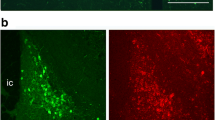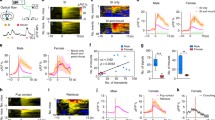Summary
Absolute refractory periods of a subpopulation of corticomedial amygdala (CMA) neurones which project to the medial preoptic/ anterior hypothalamic junction (MPH) via the stria terminalis were recorded in the female rat. Previous experiments have shown that this sub-population of CMA neurones is testosterone-sensitive in the male rat. In the ovariectomised female testosterone propionate (TP, 200 μg/day for 18–22 days) significantly reduced the mean absolute refractory period of these CMA neurones compared to oil treated controls (from 1.34 ms to 0.87 ms). In a second experiment the absolute refractory periods of these CMA neurones were measured during the pro-oestrus and di-oestrus stages of the oestrous cycle as well as in ovariectomised controls. The mean absolute refractory period of these neurones was significantly shortened at pro-oestrus (0.99 ms) compared both to animals in di-oestrus 1 (1.45 ms) and ovariectomised controls (1.42 ms). The median firing rate of these CMA neurones was also significantly increased at pro-oestrus (1.24 Hz) compared to di-oestrus 1 (0.13 Hz) and ovariectomised controls (0.09 Hz). No firing rate increase was observed after TP treatment of ovariectomised animals in the first experiment.
Results show that the testosterone-sensitive CMA neurones originally discovered in the male rat have a similar sensitivity in the female rat. They also show that the refractory periods of these neurones are shortened at pro-oestrus. Further, these same neurones also show firing rate increases at this time, although such an increase has not been observed in gonadally intact male rats when compared to castrated ones. Results are interpreted in terms of a possible functional sexual dimorphism in the output of these CMA neurones.
Similar content being viewed by others
References
Arai Y (1971) Effect of electrochemical stimulation of the amygdala on induction of ovulation in different types of persistent estrous rats and castrated male rats with an ovarian transplant. Endocrinol Jpn 18: 211–214
Carrer HF, Whitmoyer DI, Sawyer CH (1978) Effects of hippocampal and amygdaloid stimulation on the firing of preoptic neurons in the proestrous female rat. Brain Res 142: 363–367
Critchlow V (1958) Ovulation induced by hypothalamic stimulation in the anaesthetised rat. Am J Physiol 195: 171–174
Cross BA, Dyer RG (1972) Cyclic changes in neurons of the anterior hypothalamus during the rat estrous cycle and the effect of anaesthesia. In: Sawyer CH, Groski R (eds) Steroid hormones and brain function. University of California Press, Los Angeles, pp 95–102
Dyer RG (1973) An electrophysiological dissection of the hypothalamic regions which regulate the pre-ovulatory secretion of luteinizing hormone in the rat. J Physiol (Lond) 234: 421–442
Dyer RG, Pritchett CJ, Cross BA (1972) Unit activity in the diencephalon of female rats during the oestrous cycle. J Endocrinol 53: 151–160
Dyer RG, MacLeod NK, Ellendorff F (1976) Electrophysiological evidence for sexual dimorphism and synaptic convergence in the preoptic and anterior hypothalamic areas of the rat. Proc R Soc Lond [Biol] 193: 412–440
Dyer RG, Mansfield S, Yates JO (1980) Discharge of gonad-trophin-releasing hormone from the mediobasal part of the hypothalamus. Effect of stimulation frequency and gonadal steroids. Exp Brain Res 39: 453–460
Everett JW (1965) Ovulation in rats from preoptic stimulation through platinum electrodes. Importance of duration and spread of stimulus. Endocrinology 76: 1195–1201
Everett JW, Holsinger JW, Zeilmaker GH, Redmond WC, Quinn DL (1970) Strain differences for preoptic stimulation of ovulation in cyclic, spontaneously persistent oestrus, and androgen sterilized rats. Neuroendocrinology 6: 98–108
Fink G, Aiyer MS (1974) Gonadotrophin secretion after electrical stimulation of the preoptic area during the oestrous cycle of the rat. J Endocrinol 62: 589–604
Halasz B (1969) The endocrine effects of isolation of the hypothalamus from the rest of the brain. In: Martini L, Ganong WF (eds) Frontiers in neuroendocrinology. Oxford University Press, New York, pp 307–342
Jamieson MG, Fink G (1976) Parameters of electrical stimulation of the medial preoptic area for release of gonadotrophins in male rats. J Endocrinol 68: 47–70
Kendrick KM (1979) A neuronal effect of testosterone. Unpubl. Ph. D. Thesis, University of Durham
Kendrick KM, Drewett RF (1979) Testosterone reduces refractory period of stria terminalis neurons in rat brain. Science 204: 877–879
Kendrick KM, Drewett RF (1980) Testosterone-sensitive neurones respond to oestradiol but not to dihydrotestosterone. Nature 286: 67–68
Kendrick KM, Drewett RF, Wilson CA (1981) Effect of testosterone on neuronal refractory periods, sexual behaviour and luteinizing hormone. A comparison of time-courses. J Endocrinol 89: 147–155
Keppel G (1973) Design and analysis. Prentice-Hall, New Jersey
König JFR, Klippel RA (1963) The rat brain. Williams and Wilkins, Baltimore
Köves K, Halasz B (1970) Location of neural structures triggering ovulation in the rat. Neuroendocrinology 6: 180–193
Naftolin F, Brown-Grant K, Corker CS (1972) Plasma and pituitary luteinizing hormone and peripheral plasma oestradiol concentrations in the normal oestrous cycle of the rat and after experimental manipulation of the cycle. J Endocrinol 53: 17–30
Nance DM, Shryne J, Gorski RA (1974) Septal lesions: Effects on lordosis behavior and pattern of gonadotropin release. Horm Behav 5: 73–81
Nance DM, McGinnis M, Gorski RA (1976) Interaction of olfactory and amygdala destruction with septal lesions: Effects on lordosis behavior. Soc Neurosci Abstr 932: 653
Olmos de JS (1972) The amygdaloid projection field in the rat as studied with the cupric silver method. In: Eleftherion BE (ed) The neurobiology of the amygdala. Advances in behavioural biology, vol 2. Plenum Press, New York, pp 145–204
Powers B, Valenstein ES (1972) Sexual receptivity: Facilitation by medial preoptic lesions in female rats. Science 175: 1003–1005
Raisman G, Brown-Grant K (1977) Reproductive function in male and female rats following extra- and intra-hypothalamic lesions. Proc R Soc Lond [Biol] 198: 267–278
Terasawa E, Timiras PS (1968) Electrical activity during the estrous cycle of the rat: Cyclic changes in limbis structures. Endocrinology 83: 207–216
Terasawa E, Kawakami M, Sawyer CH (1969) Induction of ovulation by electrochemical stimulation in androgenized and spontaneously constant oestrous rats. Proc Soc Exp Biol Med 132: 497–504
Velasco ME, Taleisnik S (1969) Release of gonadotrophins induced by amygdaloid stimulation in the rat. Endocrinology 84: 132–139
Author information
Authors and Affiliations
Additional information
Supported by the Medical Research Council
Rights and permissions
About this article
Cite this article
Kendrick, K.M. Effect of testosterone and the oestrous cycle on neuronal refractory periods and firing rates of stria terminalis neurones in the female rat. Exp Brain Res 44, 331–336 (1981). https://doi.org/10.1007/BF00236571
Received:
Issue Date:
DOI: https://doi.org/10.1007/BF00236571




